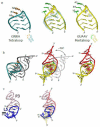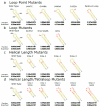Identification of a GUAAY Pentaloop Sequence Involved in a Novel RNA Loop-Helix Interaction
- PMID: 27771480
- PMCID: PMC5138090
- DOI: 10.1016/j.jmb.2016.10.015
Identification of a GUAAY Pentaloop Sequence Involved in a Novel RNA Loop-Helix Interaction
Abstract
Large RNAs often utilize GNRA tetraloops as structural elements to stabilize the overall tertiary fold. These tetraloop-receptor (TR) interactions have a conserved geometry in which the tetraloop docks into the receptor at an angle of ~15° from the helix containing the receptor. Here, we show that the conserved GUAAY pentaloop found in domain III of group IIB1 introns participates in a novel class of RNA tertiary interaction with a geometry and mode of binding that are significantly different from that found in GNRA TR interactions. This pentaloop is highly conserved within the IIB1 class and interacts with the minor groove of the catalytic domain V. The base planes of the loop and receptor nucleotides are not coplanar and greatly deviate from standard A-minor motifs. The helical axis of the GUAAY stem loop diverges ~70° from the angle of insertion found in a typical GNRA TR interaction. Therefore, the loop architecture and insertion orientation are distinctive, with in vitro splicing data indicating that a GNRA tetraloop is incompatible at this position. The GUAAY pentaloop-receptor motif is also found in the structure of the eukaryotic thiamine pyrophosphate riboswitch in the context of a hexanucleotide loop sequence. We therefore propose, based on phylogenetic, structural, and biochemical data, that the GUAAY pentaloop-receptor interaction represents a novel structural motif that is present in multiple structured RNAs.
Keywords: RNA structure; ribozyme.
Copyright © 2016 Elsevier Ltd. All rights reserved.
Figures




Similar articles
-
Model for an RNA tertiary interaction from the structure of an intermolecular complex between a GAAA tetraloop and an RNA helix.Nature. 1994 Nov 3;372(6501):111-3. doi: 10.1038/372111a0. Nature. 1994. PMID: 7526219
-
The GANC tetraloop: a novel motif in the group IIC intron structure.J Mol Biol. 2008 Nov 14;383(3):475-81. doi: 10.1016/j.jmb.2008.08.043. Epub 2008 Aug 26. J Mol Biol. 2008. PMID: 18773908 Free PMC article.
-
Structural variation and uniformity among tetraloop-receptor interactions and other loop-helix interactions in RNA crystal structures.PLoS One. 2012;7(11):e49225. doi: 10.1371/journal.pone.0049225. Epub 2012 Nov 9. PLoS One. 2012. PMID: 23152878 Free PMC article.
-
An RNA folding motif: GNRA tetraloop-receptor interactions.Q Rev Biophys. 2013 Aug;46(3):223-64. doi: 10.1017/S0033583513000048. Epub 2013 Aug 5. Q Rev Biophys. 2013. PMID: 23915736 Review.
-
Recognition modes of RNA tetraloops and tetraloop-like motifs by RNA-binding proteins.Wiley Interdiscip Rev RNA. 2014 Jan-Feb;5(1):49-67. doi: 10.1002/wrna.1196. Epub 2013 Oct 3. Wiley Interdiscip Rev RNA. 2014. PMID: 24124096 Free PMC article. Review.
Cited by
-
GluK2 kainate receptor subunit-selective, potentiating RNA aptamer.Sci Rep. 2025 Sep 11;15(1):32405. doi: 10.1038/s41598-025-15323-y. Sci Rep. 2025. PMID: 40935837 Free PMC article.
-
AMIGOS III: pseudo-torsion angle visualization and motif-based structure comparison of nucleic acids.Bioinformatics. 2022 May 13;38(10):2937-2939. doi: 10.1093/bioinformatics/btac207. Bioinformatics. 2022. PMID: 35561202 Free PMC article.
References
-
- Cate JH, Gooding AR, Podell E, Zhou K, Golden BL, Kundrot CE, et al. Crystal structure of a group I ribozyme domain: principles of RNA packing. Science. 1996;273:1678–85. - PubMed
-
- Jucker FM, Pardi A. Solution structure of the CUUG hairpin loop: a novel RNA tetraloop motif. Biochemistry. 1995;34:14416–27. - PubMed
-
- Jaeger L, Michel F, Westhof E. Involvement of a GNRA tetraloop in long-range RNA tertiary interactions. J Mol Biol. 1994;236:1271–6. - PubMed
Publication types
MeSH terms
Substances
Grants and funding
LinkOut - more resources
Full Text Sources
Other Literature Sources

